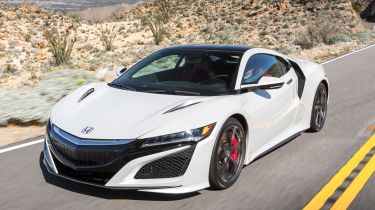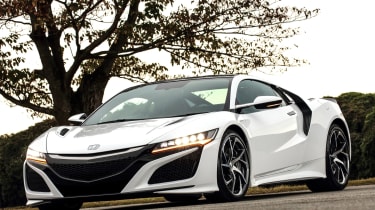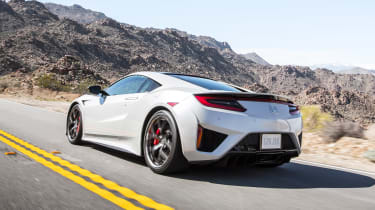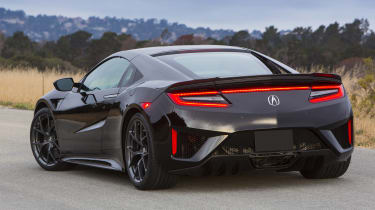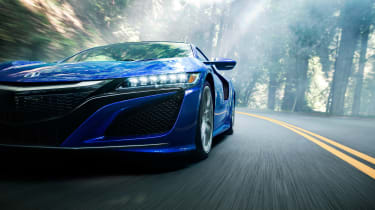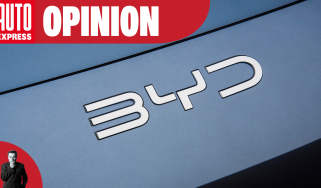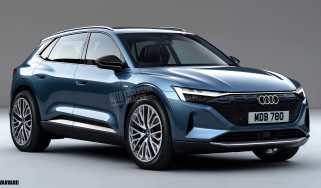Honda NSX review
The Honda NSX is an accomplished everyday supercar with hi-tech features and a space-age look

The Honda NSX is back as a hybrid supercar, and it's the flagship of the Honda range. While the original NSX for sale in the 1990s used to be a delicate sports car designed to rival the Porsche 911 of the time, the new model throws as much technology as possible into the mix to create a near-200mph supercar.
With a six-figure price tag and stunning looks, the Honda NSX has all the right ingredients to be a challenger in the supercar class. It should be considered alongside cars as varied as the rear-engined Porsche 911, V10-powered four-wheel-drive Audi R8, plug-in hybrid BMW i8, the McLaren 570 series and front-engined rear-drive coupes such as the Jaguar F-Type SVR and Mercedes-AMG GT. If you're a fan of Japanese metal, then the Nissan GT-R and Lexus LC are very different beasts, albeit with a similar technological bent.
Like many other Japanese sports cars, the current NSX had a long gestation period. We first saw it in concept form in 2012, but it didn't go on sale in the UK until 2016. As with the old NSX, it has a mid-mounted V6 petrol engine, but this time around it features twin-turbos and electrical assistance to make 573bhp and a healthy 645Nm of torque, while the three-motor set-up (two up front, one at the rear) gives the NSX four-wheel drive. The Honda NSX accelerates from 0-62mph in 2.9 seconds, and has a top speed of 191mph.
Used - available now

2023 Polestar
2
29,317 milesAutomaticElectric
Cash £20,900
2022 Toyota
C-HR
20,561 milesAutomaticPetrol1.8L
Cash £20,000
2020 Porsche
718 Cayman
45,800 milesAutomaticPetrol2.5L
Cash £42,995
2018 Audi
RS5
53,700 milesAutomaticPetrol2.9L
Cash £31,995That hi-tech running gear is draped in sharp, angular, mid-engined coupe bodywork that looks fittingly dramatic and makes the NSX look like no other supercar on the road. The low-set nose and wide, slender LED headlights look purposeful (although are slightly ruined when you fit a compulsory UK number plate), while the sharp lines flow to the back of the car where wide arches blend with the engine cover and smooth rear to complete the muscular look.
Inside, the cockpit is snug, and while Honda claims that the NSX is a supercar you can use everyday, it does feel a little more cramped than a 911 or R8. Another downside is that not only is sat-nav optional, but it's the same system found in the Civic hatch, so it's not the most user-friendly system to use.
You can buy an NSX at a Honda dealer for around £145,000. Depending on your viewpoint, this is either really expensive for a Honda, or a great price to pay for a car that showcases the cutting edge of Honda road car technology and the progress of Japanese car culture as a whole.
Honda NSX history
The original Honda NSX arrived in 1990, and famously benefitted from F1 legend Ayrton Senna in its development. That car was designed to offer the performance of cars like the Ferrari 328 and 348, but with the reliability and everyday drivability of Honda's then-supermini, the Civic.
Originally the NSX came with a naturally aspirated 3.0-litre V6 engine with VTEC variable valve timing that had an 8,300rpm redline and produced 250bhp. Aluminium was used extensively in the car's construction to save weight, too, which helped the NSX deliver sharp and engaging handling.
The NSX-R of 1992 saw the introduction of the Type R brand, and with it a focus on light weight and track-focused performance. Soon after, the NSX-T was a targa-topped version of the NSX, popular with buyers in the US, where the car was sold as the Acura NSX.
A major update in 1997 saw the engine increased to 3.2 litres, and power up to 290bhp, while Type S and Type S Zero versions offered a more focused drive. 2002 saw the original car's pop-up headlamps replaced by fixed xenon lights, and chassis revisions helped to deliver improved handling, while a new NSX-R was also added to the range. This added a hand-built V6 engine which had the same on-paper power output as the standard car, although on the road these models felt a lot faster.
The NSX finally went out of production in 2005 after 15 years. Rumours of a new NSX started not long after its demise, and initially the plan was for a front-engined rear-drive machine to rival the Lexus LFA. While a concept car made an appearance, it went on to become the Honda HSV 010 GT, which Honda raced in the Japanese Super GT championship from 2010-2013.
The current NSX was first seen in 2011 as a prop in The Avengers movie, with the final production version arriving in 2016. One major difference between the old NSX and new is that while the original car was built in Japan, the current model is built in the USA.
The Honda NSX is an excellent supercar. It offers something genuinely different to its established rivals, thanks to its sophisticated hybrid powertrain, while its aluminium underpinnings are a throwback to the iconic original.
The NSX’s concept-car looks hide a car that’s surprisingly easy to drive at high speed. Performance is staggering, thanks to the car’s twin-turbo V6 petrol engine and trio of electric motors, while a selection of clever driver aids mean the car is much more nimble than you might expect for such a heavy machine.
It’s not perfect – the options list seems incredibly pricey, given the Honda’s £140k+ price tag, while the hybrid powertrain is designed for performance over efficiency, so it's not very economical. It’s not quite as involving to drive as the best in this class either, but it’s a worthy successor to the original NSX.
Engines, performance and drive
In keeping with the NSX’s hi-tech roots, Honda has gone bold with the newcomer’s technical specification. Sitting behind the driver is a twin-turbocharged 3.5-litre V6 that’s paired with a nine-speed automatic gearbox driving the rear wheels.
However, sitting between these two units is a 47bhp electric motor that acts as a starter and provides extra power. That’s not all, as each front wheel gets its own 36bhp electric motor, giving the car four-wheel-drive traction. The combined output for this petrol/electric set-up is a dizzying 573bhp.
This hybrid powertrain has been built with performance in mind, and at the track it set a blistering pace. Yet what’s really impressive about its performance is how natural it feels, with the trio of electric motors integrating seamlessly with the internal combustion unit. Adding to the sensation of speed is the nine-speed gearbox, serving up seamless shifts via the steering wheel paddles. The V6 engine emits a sporty snarl as it spins to its 7,500rpm rev limit, plus there’s some whoosh and chatter from the turbochargers.
The NSX tips the scales at a hefty 1,776kg, yet it feels remarkably agile through a series of corners. This nimbleness can be partly explained by the electric front motors, which provide a torque vectoring function, reducing understeer and boosting traction. The newcomer also benefits from quick and well weighted steering, so you can place the car accurately through bends. There’s bags of grip, too, while the mid-engined layout delivers near-perfect balance.
Twist the rotary dial on the console and you can pick from Sport, Sport+ and Track modes. Each adds differing weight to the steering, sharpness to the throttle response and stiffness to the two-stage adaptive dampers.
You can also add carbon ceramic brakes, which are wallet-melting at around £9,000. However, not only does this set-up deliver eye-popping stopping power, it works seamlessly with the regenerative system – although the pedal travel is long, which can be disconcerting when stopping from high speed.
Engage the Quiet setting, and the engine noise is significantly reduced, while the NSX will run for short periods in near-silent electric mode. The dampers also soften to deliver a less hard-edged ride than in a 911, while the nine-speed box smoothly slurs ratios.
Engines
There’s just one engine choice in the Honda NSX – a 3.5-litre twin-turbo V6, mated to a trio of electric motors for a combined power output of 573bhp. The engine puts out 500bhp on its own, along with 550Nm of torque.
The real trickery lies in the electric motors. One sits between the engine and the nine-speed dual clutch transmission, putting out 47bhp. There’s also a pair of motors on the front axle, putting out 36bhp each and bestowing the NSX with four-wheel drive.
MPG, CO2 and Running Costs
With a price tag in excess of £140,000, the NSX rivals the likes of the Audi R8, top-spec versions of the Porsche 911, the Mercedes-AMG GT, Jaguar F-Type SVR and McLaren 570S. However, standard kit is something of a disappointment when compared to these rivals. Honda have been frankly stingy with the equipment on the NSX, in fact. Parking sensors – almost an essential in a car like this – cost around £1,700, while sat-nav will set you back another £1,700, and even then the unit looks rather out of place in the NSX because it's the same one you'll find in the Civic hatch, and not particularly advanced at that.
While most hybrids promise greater fuel efficiency than traditionally powered models, it's not the purpose of the NSX's drive system, as the 500bhp engine is the chief motivator of the car, with the three electric motors contributing extra boost when needed.
Official fuel consumption of 28.3mpg is unimpressive next to the likes of the BMW i8’s 100+mpg – although you shouldn’t expect either car to hit their official figures. Still, CO2 emissions of 228g/km mean a high Benefit in Kind tax bill if you’re lucky enough to use the NSX as a company car. It's not quite in the highest tax band, but might as well be with that list price factored in.
Depreciation
The limited production volumes of the NSX have helped to keep retained values high, with the sole model on offer expected to retain around 59 per cent of its value after three years. In comparison, the Audi R8 retains around 52-56 per cent of its value depending on which version you choose, while the BMW i8 retains around 48 per cent, reflecting the used market's suspicions about plug-in hybrid tech. Elsewhere, the Nissan GT-R - an older Japanese supercar - retains nearly 61 per cent of its value.
Interior, design and technology
The NSX’s bold styling has the ability to stop traffic at 40 paces. With its aggressive nose treatment, wide stance and low-slung profile, the Honda looks every inch a supercar contender, although attaching a mandatory UK number plate to the front does spoil the looks of that low nose. Glance down the sides of the car and you’ll see daring angles and sharp lines, while large air intakes sit ahead of the rear wheelarches. Move around to the back and you’ll spot the full-width LED tail-lamps and large diffuser that houses a centre-exit quad exhaust.
Yet these concept car looks are as functional as they are futuristic. The various vents, vanes and creases help to manage airflow over the NSX’s pody panels, helping to reduce lift and boosting downforce. Honda claims the aerodynamic tuning is so efficient that, unlike a Porsche 911 or other sports car rivals, the NSX doesn’t need to resort to movable spoilers and flaps.
The cabin is dominated by a large transmission tunnel that flows between the seats and into the centre console. Here you’ll find a metal-finish rotary controller for the driving modes and a large touchscreen infotainment system, although Honda Civic owners will be familiar with this, as it's identical to the one found in the hatchback, and it's not as hi-tech as the rest of the car.
A low-slung driving position places you firmly at the centre of the action, while the dials are placed on a large TFT screen that adds to the car’s futuristic style. Other racy touches include the flat-bottomed steering wheel with large metal-effect paddles.
Overall build quality is good and the NSX’s cabin feels solidly screwed together, yet some of the materials look and feel a little low rent. For instance, the metallic-effect plastic would look cheap in a Civic, let alone a £140,000+ supercar.
Practicality, comfort and boot space
Supercars are never the most practical choices, but even by class standards, the Honda is poor here. While the driver and passenger get plenty of space, with decent head and legroom, storage is limited to a glovebox and a lidded cubby behind the seats. There are no door bins or cup-holders, although a trinket tray between the front seats will hold most smartphones.
Carrying capacity is also at a premium, with the car’s mid-engined layout limiting boot space to a cramped 110-litre compartment behind the engine. Worse still, not only is the load bay small, it’s awkwardly shaped and doesn’t have a flat floor.
Up front, rivals like the Porsche 911 and Audi R8 have additional storage, while a McLaren 570GT is roomier still. But the front end of the NSX is occupied by the two additional electric motors, so there's no additional storage to be found.
Visibility is surprisingly good, although some taller drivers might feel that the roof around the frameless windows is a little close to your head. At least a reversing camera helps take the sting out of parking, but parking sensors are an expensive option.
Dimensions
The Honda NSX measures 4,470mm long and 1,940mm wide, with a wheelbase of 2,630mm. It also stands 1,215mm tall, so the NSX truly does fit the supercar brief in terms of size and shape. One limiting factor of the NSX might be its ground clearance. The low-slung suspension means negotiating urban speed humps might be an issue, and Honda doesn't offer a lift kit to raise the nose of the NSX to help clear them.
A kerb weight of 1,725kg is pretty hefty, but is only slightly heavier than an Audi R8, while the Porsche 911 is around 200kg lighter.
Reliability and Safety
The Honda NSX is a hand-built supercar that's assembled at Honda's Performance Manufacturing Center in Marysville, Ohio, US. That should mean it's finished to a higher standard than Honda's mainstream production cars, which already have a high level of quality about them. It's just a shame that not all of the materials used inside are as classy as you'll find in an Audi R8 or McLaren 570S.
As a brand, Honda does pretty well in our Driver Power satisfaction surveys, although the positive feedback we get from owners tends to pick highlights in areas that don't really apply to the NSX. Honda drivers like the practicality and fuel economy their cars offer, but these two aspects won't be great in the NSX. Owners did criticise their cars for the dated infotainment offered, which is something the NSX will have in common with the rest of the Honda range.
The NSX hasn’t been tested by Euro NCAP, but with six airbags, stability control and a powerful braking system it should prove safe. That said, features such as autonomous emergency braking, lane departure warning and adaptive cruise control aren’t available.
Warranty
The standard Honda warranty is three years, but with a 60,000 mile limit. This three-year cover is two years short of the cover offered by Japanese rival Toyota, although its sister brand Lexus also only offers three years' cover, which is what you'll get if you choose an LC coupe. In addition, Honda offers a 5-year/90,000 mile warranty on cars with its Integrated Motor Assist (IMA) hybrid technology. Check with an authorised NSX dealer for specific warranty cover for the flagship.
Servicing
Service intervals for the Honda NSX work out to every year, but not all Honda dealers are authorised NSX service specialists. Whether your local dealer is or isn't authorised, you can expect fairly hefty bills for a car packed with high-performance running gear and cutting edge tech.

